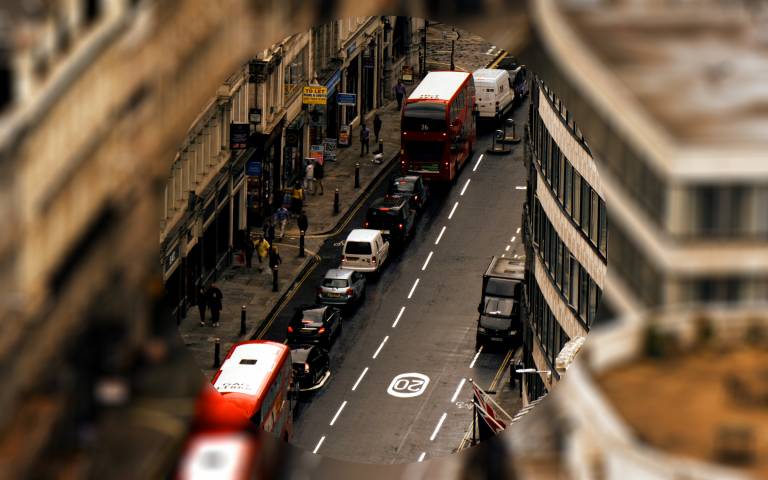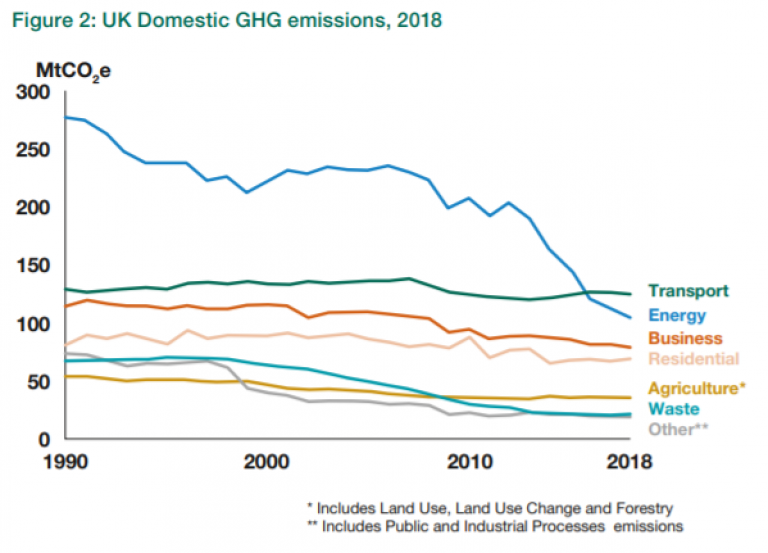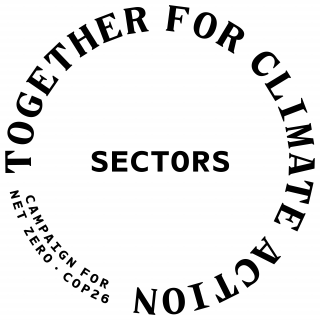Transport in cities
16 August 2021

At a glance
- While other UK sectors have improved their record in reducing carbon emissions, transport emissions have barely changed in recent decades – it is a “hard-to-decarbonise” sector
- With available technologies and research on innovation progressing, there needs to be a focus on the transition to adopt and implement available innovation, along with supporting infrastructure.
- As well as technological change, intelligent urban design and planning can reduce demand for transport. Thus truly sustainable solutions for transport in cities must also be integrated with decisions in those other sectors.
- A future zero-carbon urban transport system could also deliver substantial additional social benefits to health, well being, convenience and social equality. Collaboration with other economic sectors is needed to achieve such benefits.
What is the problem?
Emissions reductions within the transport sector are urgently needed.
The global transport sector is responsible for over 24% of global CO2 emissions and over 14% of annual greenhouse gas (GHG) emissions – it must decarbonise rapidly if global climate change targets are to be met (IEA, 2020). Around 72% of total transport CO2 emissions come from road transport – the use of cars and trucks to move people and goods around and between cities and towns.
However, the transport sector is hard to decarbonise. In the UK, for example, whereas all other sectors have shown some decline of emissions over the last 30 years, transport emissions have barely reduced at all (Figure 1). At the same time, congestion is affecting health, well-being and efficiency, costing the UK nearly £8 billion annually [1].
But why is transport so hard to decarbonise? In this explainer we explore the challenges to decarbonising transport, focusing on transport in cities. We also consider potential strategies and solutions.

Figure 1: UK Domestic GHG emissions, 2018 (source: Department for Transport (2020). Decarbonising Transport: Setting the Challenge)
What are the key characteristics of the problem?
There are a number of issues that need to be considered to address the issue of decarbonisation of transport in cities:
- While gradual improvements in vehicle technologies are helping to reduce CO2 emissions per mile in all types of vehicle, a more radical transformation in vehicle technology would be required to enable complete decarbonisation. One technology that could enable zero-carbon transport is the electric vehicle – provided of course that it is charged with electricity that is itself produced from zero-carbon sources. However, while advances have been made in fully electric cars, the full electrification of heavy-goods vehicles could be more challenging.
- Although CO2 emissions per mile have reduced, demand for transport and miles driven are on the rise, with the UK government projecting continued increases [2].
- The transition to net-zero carbon transport in cities has no ‘one size fits all’ solution. In some areas, especially densely populated urban areas, public transport can be an economically viable alternative to car travel. However, in other less densely populated areas, traditional forms of public transport such as a regular bus service, might not be economically viable. Such areas could benefit from forms of public or shared transport that were more responsive to demand.
- The transition to reducing emissions is influenced by a multitude of actors across different geographies. Governments, companies, and citizens need to understand the challenge and they need to be part of the inevitable changes.
- Why we move around depends on the activities we want and need to do. This means that the location of our places of work, education or health services determine our need to use transport modes. While the transport sector can provide technology and systems to minimise the impact of those trips, it is also important to start thinking about the need to travel in itself. Transport professionals need to collaborate more with other planners and sectoral experts, to avoid planning decisions taken in other sectors resulting in increasing the demand for transport. For example, if the nearest hospital is 10 miles away from my home, and there is no public transport, then I would probably need to use a car if my children are ill. In this example, decisions of where to locate health facilities, and on the provision of public transport, are making me increase my emissions.
In addition, the current transport system comes with a wide range of other problems that will continue to exist even if we were ready to deploy fully carbon-neutral transport for all modes tomorrow. The government, industry and policy makers need to address pertinent and long existing issues such as road safety, congestion, accessibility, use of space and equity issues, which are all related to transport as a system. For instance, while electric vehicles reduce CO2 emissions, they don’t in themselves tackle issues of congestion and the effective use of public space.
These issues raise a number of challenges for transport decarbonisation in cities:
- Achieving fully carbon-neutral vehicle fleets remains a technical challenge. Whilst electric cars are improving in performance and reducing in cost, the equivalent technology for other vehicle types, especially heavy goods vehicles, is not mature enough yet or is non-existent. Second, even if with the required technology, the duration of use for different modes of transport, the strong position of the second-hand vehicles market, and the significant investments required (both for individuals, households and companies), make it unlikely that fully carbon-neutral fleets will be available by 2050.
- Infrastructure provision: Several aspects of electric vehicles deployment have not been fully addressed yet. For example, how will people charge their vehicles? What happens to people who do not have private parking to charge at home? Will charging be as fast as refuelling and will people accept longer times for charging than refuelling? Who will pay for the vast investments required? What are the implications in terms of wellbeing, built environment and congestion?
- Clean energy needs to be central when we are referring to the decarbonisation of transport. A switch to electric vehicles when electricity is still produced from fossil fuels will still result inthen greenhouse gas emissions. The surge in demand for electricity resulting from an increased number of electric vehicles also needs to be accommodated.
- A whole-system approach is needed: a better understanding of how much carbon the technology (for example an electric scooter) emits from the resources used to build it, how much energy it uses during its lifetime and how it can be recycled or how it would end up, would allow the development of policies to prevent outsourcing of emissions and promote concepts such as circular economy.
- Encouraging other modes of transport and business models for passenger mobility (e.g. car clubs, walking and cycling), and more efficient operation of freight transport fleets to improve efficiency and reduce carbon emissions, should be promoted.
The challenge of transport decarbonisation requires action across all stages of transport development, from policy and strategy through to operation, maintenance and end-of-life.
What is the solution?
There are several overlapping and interconnected possible strategies to decarbonise urban transport. The current dominant approach of encouraging the switch to electric vehicles can be supported by complementary strategies. Such strategies could include the promotion of “active travel”, such as walking and cycling; the integration of new mobility technologies and services within the transport system – for example shared mobility options such as the London Santander bikes, or on-demand transport apps such as Uber; logistical improvements in the system efficiency of the first and last mile of deliveries and trips; and urban planning policies such as low-traffic neighbourhoods, and the integration of residential buildings with shops and other services, to avoid the need to travel long distances for everyday amenities. Rather than relying on any one of these approaches exclusively, an integrated portfolio of such strategies can bring us closer to the achievement of zero-carbon transport. Moreover, a carefully integrated portfolio of strategies could increase the likelihood that, alongside addressing climate change concerns, other societal goals such as improved air quality, health benefits, reduced congestion and social equity, can also be addressed.
New technologies and infrastructure
New technologies are a key contributor to a net-zero transport system. The adoption of clean vehicle technologies (such as battery electric, hydrogen fuel cell vehicles, or vehicles running on other fuels produced from zero-carbon sources [3]) is critical for achieving the COP26 goal of securing global net-zero emissions by mid-century. To achieve full decarbonisation, a fleet of entirely zero-emission vehicles (ZEVs) will be needed by 2050. This implies ensuring that only 100% zero-emission vehicles are sold by the early 2030s, and by 2035 at the very latest, with any remaining internal combustion engine (ICE) vehicles that were still in circulation being banned by 2050.
Investments in infrastructure that supports these new technologies are also needed. Electric charging infrastructure, electricity generation and distribution systems, hydrogen refuelling, low-carbon hydrogen generation and production of biofuels should be prioritised. These will all require support from governments, together with consumer engagement. It is also important that policy makers should be adaptable and able to learn from the experiences of early attempts to roll out these technologies and infrastructures, and able to to re-apply the lessons they learn quickly.
New mobility services based on shared economy concepts
A number of new concepts in mobility have the potential to deliver sustainability benefits. “Mobility as a Service” (MaaS; Kamargianni and Matyas, 2017) refers to the integration of different kinds of transport – potentially including public transport, car- or bike-sharing, taxi or hire-car – into a single overall “mobility service”, which a user can access on demand. Emerging examples of such services can be seen in the information provided by apps such as CityMapper or WHIM in the West Midlands. By increasing convenience for users through the the provision of real-time information, such apps could help to optimise the use of public and other shared transport systems, thereby increasing access to and use of public transport, and supporting the transition to an era where the use of different transport modes is driven by their efficiency and not by habits or preferences.
The effectiveness of mobility as a service will increase as more varied forms of urban transportation are offered for integration within the overall service. Shared mobility and micromobility options, such as e-scooters, could help to fill in gaps within a transport network that it would not be economically viable to meet with traditional forms of public transport. Micromobility could substitute for some car-trips especially when adequate levels of infrastructure provision are in place. Micromobility could also bring about additional benefits – such as improved health, as the users will be exercising more than they would had they made the whole journey in a car; and reduction of road mortality. Even for remaining journeys for which a car may still be the only option, concepts like car sharing or ride pooling offer car-like flexibility, and are found to reduce car ownership overall. These new mobility services can also help to increase the sustainability of the crucial first and last mile of trips, either for passengers or freight.
Active transport
Traditionally, the promotion of walking and cycling in cities has tended to be overshadowed by the needs of motorised transport, for example in the allocation of public space. Although there has been a slow shift over the past few decades, the focus of transport planning, infrastructure developments and operational choices (e.g. prioritization of car traffic at traffic lights) has been on motorised transport. This has had an adverse effect on the structure of urban environments, where most public space is allocated for transport of motorised vehicles, such as roads and parking spaces. Women, who are less likely to have car access are disadvantaged, while families and disabled people require improved infrastructure to increase access and reduce safety concerns.
Education, awareness and a change in mindset
Education and awareness initiatives are important in shifting public attitudes and motivation, and greater awareness of the health impacts of emissions coming from transport will reinforce this. Fossil fuels will continue to be an important part of the transport mix for some years to come, not least because vehicles sold today will remain in use for many years. Policies to curb car use (such as encouraging modal shifts to public transport, cycling and walking), can have a significant near-term effect on reducing pollution from fossil-fuelled vehicles, as well as in the longer tem reducing the amount of clean electricity and other resources that will be required to deliver zero-emission mobility. Once clean transport choices are accessible, available, affordable and convenient, the shift to clean transport systems could happen very quickly indeed.
Policy making and governance
The way people and goods are moved around is a matter of concern for all. Good decisions about transport decarbonisation require the broad participation and the further involvement of civil society in the development of policies, and education at all levels. Suppot is needed for school projects, and for local transport, urban planning and environment officers, to engage citizens and gather the data required for making low-carbon transport improvements, as part of a clear and detailed strategy. Different levels of government will also need to work towards shared goals, with open data systems and collaboration between policy makers, businesses and civil society.
What action is now needed for transport decarbonisation?
Action is now needed to support the transition to zero-carbon transport. Governments with the support of business and civil society should commit to:
- Infrastructure improvements to support clean vehicle technologies, new mobility services, and active transport.
- Address geographical disparities in the provision of transport services between cities and rural areas.
- Address inequality in transport to support accessibility and mobility for women, children, the unemployed and others to make cities a place to live and not just a place to work.
- Increase engagement between national and local governments and promote the discussion between private and public sectors.
- Increase knowledge exchange and funding opportunities for less developed countries. This provides an opportunity for the UK to increase its soft power and also increase business opportunities.
- Better alignment between transport and urban planning.
Most of these actions require funding, planning more time and space for local authorities to work on projects. Local and municipal authorities have a huge role in helping the UK get to net zero, but currently do not have the resources and skills to play it effectively.
Conclusion
The recently released Transport Decarbonisation Plan [4] sets out the UK’s commitments to get to net zero by 2050. While the commitments are very much needed, the plan must be supported with more policy detail, recommended actions, and include themes related to the transition to net zero. The Plan says that “it’s about doing the same things differently”. As transport is a support activity for the economy and society, “doing things differently” in transport has profound implications across all economic sectors. Doing transport differently is a major challenge, but one with great opportunities to make the UK’s cities and how people move around them, more healthy, sociable, equitable and convenient – as well as more sustainable.
In text references
[1] https://inrix.com/press-releases/scorecard-2018-uk/
[2] https://assets.publishing.service.gov.uk/government/uploads/system/uploa...
[3] Fuels made of renewable sources. For instance, synthetic methanol can be produced by using wind power: https://www.autoevolution.com/news/future-porsche-cars-to-run-on-efuels-...
[4] Transport decarbonisation plan - GOV.UK (www.gov.uk)
Key references for further information
- Brand, C, Anable, J, Ketsopoulou, I, and Watson, J. "Road to Zero or Road to Nowhere? Disrupting Transport and Energy in a Zero Carbon World." Energy Policy , 139 , Article 111334. (2020) (2020): Energy Policy , 139 , Article 111334. (2020). Web.
- Drummond, P. "Assessing City Governance for Low-carbon Mobility in London." Sustainability , 13 (5) , Article 2480. (2021) (2021): Sustainability , 13 (5) , Article 2480. (2021). Web.
- Antoniou, C, Chaniotakis, E, Katrakazas, C, and Tirachini, A. "Editorial: A Better Tomorrow: Towards Human-oriented, Sustainable Transportation Systems." European Journal of Transport and Infrastructure Research , 20 (4) Pp. 354-361. (2020) (2020): European Journal of Transport and Infrastructure Research , 20 (4) Pp. 354-361. (2020). Web.
- Kamargianni, M., and M. Matyas 2017. The Business Ecosystem of Mobility as a Service. Presented at the 96th Transportation Research Board Annual Meeting, Washington DC, 8-12 January 2017 . Available at: https://www.maaslab.org/copy-of-maas-publications
 Close
Close


